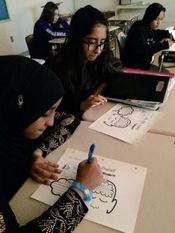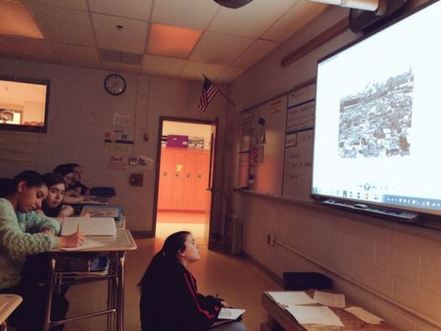Once again collaboration was key in this effort. Gretchen found compelling images for my students to examine and was able to provide me with lots of options. When starting our 7th grade Great Depression Unit, our class examined an image of Seattle, Washington. I dare anyone to look at this image and not start formulating questions about the place and time depicted. It's impossible. This photograph begs questions. Tapping into the Visible Thinking Strategies, I asked students to use a graphic organizer to write down their reflections: What did they see? What did they think? And what did the image make them wonder about? With the image projected on the Smartboard they tackled the graphic organizer. It was such a perfect teaching and learning moment. There we were, all collectively focusing, looking for answers about the past. The learning was palpable. You could feel it in the room. The discussions that followed were rich and thoughtful. Students noticed things I didn't and asked original questions. "Why would someone have to live in such a place?" "What did people do to find themselves in this situation?" "How would you survive if bad weather hit?" Students who don't readily engage in critical thinking -- had the chance to see the thought process of their peers modeled when they did a think-pair-share. Most importantly, the students personally connected with the unit we are about to jump into. Below you'll find ideas for incorporating images into the beginning of a unit as well as some of Gretchen's favorite sites for finding images. Idea 1: Image as Introduction Have students See, Think, Wonder about an image using a graphic organizer. Then, do a Think, Pair, Share, allowing students to connect with one another about the image. Idea 2: Image as a Mystery Using the "Zoom-In Inquiry" technique from Teaching with Primary Sources (Library of Congress), reveal bits and pieces of an image at the introduction of a unit as a way of sparking questions and discussion. Show one piece of the image and collect the students thoughts before showing them another segment of the same image, until eventually the entire image is revealed. This allows students to predict and revise their thinking as they see more and more. Check out some of the pre-existing zooms that TPS has already created (and if you teach a content area other than Social Studies, TPS has zoom-ins for math, science, art, language arts as well) make your own. We'd love to see what you put together! And, have you seen these picture books that make use of this technique? These would be a fun way to introduce the concept. Idea 3: Image as a Puzzle Divide students into groups and give them each one part of the same image. Have them fill out a graphic organizer: Who, What, When, Where, Why? Then on the Smartboard reveal the image piece by piece, letting students explain their thinking. Finally, examine the image as a whole (shout out to the George Washington Teacher Institute for this idea!). Resources for Images
We hope you are inspired to try using images as a lesson introduction. Pictures really can say a thousand words -- and with the right activity those words could be the insightful words of your students, music to any teachers' ears. Until next time, Corey & Gretchen You might also like:
4 Comments
Jes
4/29/2016 11:28:33 pm
I love the idea of using photos this way! As an ending to a unit, it might be cool to have the students find an image they find compelling that best captures what they learned from the unit. Having them explain why they chose it would be a good way to examine what they are taking away from the unit.
Reply
Gretchen
4/30/2016 07:37:39 am
Jes, absolutely love the idea of using an image as unit encapsulation to reflect student learning! Thanks for sharing!
Reply
Julia
5/1/2016 09:52:28 pm
I love this idea! In an English class, I can see this being especially effective in exploring/understanding setting prior to reading.
Reply
Gretchen
5/2/2016 07:40:15 am
Julia- love the idea of "found poetry!" Sounds like it could work in any content area, depending on the sources of the text.
Reply
Your comment will be posted after it is approved.
Leave a Reply. |
Who We Are
Join our list!Archives
September 2020
Categories
All
|








 RSS Feed
RSS Feed